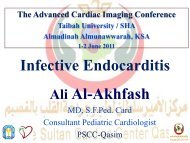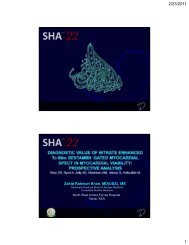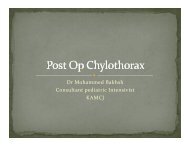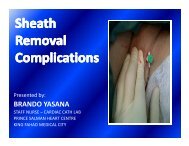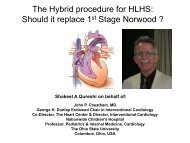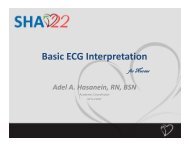aortic valve and aortic valve and aortic root anatomy - Sha ...
aortic valve and aortic valve and aortic root anatomy - Sha ...
aortic valve and aortic valve and aortic root anatomy - Sha ...
Create successful ePaper yourself
Turn your PDF publications into a flip-book with our unique Google optimized e-Paper software.
AORTIC VALVE ANDAORTIC ROOT ANATOMYRuggero De PaulisProfessor <strong>and</strong> ChiefDepartment of Cardiac Surgery, European Hospital, Rome,Italy
“nessuno effetto in natura e sanza ragione; intendi la ragione e non ti bisognasperienza““nothing in nature is without reason; underst<strong>and</strong> the reason <strong>and</strong> youdon’t need experience”
The three anatomic variations
“perche il buso della arteria aorto e trianghulare”“why the orifice of the <strong>aortic</strong> artery is triangular”Royal Library, Windsor 19117v. Leonardo’s sketch of a tricuspid <strong>valve</strong> inserted in a circle in itsopen <strong>and</strong> closed configuration. (The Royal Collection © 2004, Her Majesty Queen Elisabeth II)
Anatomy...not only leaflets (the <strong>aortic</strong> <strong>root</strong>)
Anatomical designTwo fixed rings: The skeleton of the <strong>root</strong>
Aortic <strong>root</strong>The <strong>aortic</strong> <strong>root</strong> is a dynamic unit that allowseasy opening <strong>and</strong> closing <strong>and</strong> shares stressfor the <strong>valve</strong> leafletsST junctionSinuses of ValsalvaAnnulusLeaflets
Normal <strong>anatomy</strong> (nonpressurized)ST junctionVl Valsalva l sinusesAortic annulusAORTIC ANNULUS> ST JUNCTIONwith a 1 to 1.15 ratioAcar C. 6th Symposium on <strong>aortic</strong> <strong>and</strong> mitral reconstructive surgery. Brussels 2006
Echocardiographic <strong>anatomy</strong>ST junctionThe sinotubular junction is largerthan the annulus with a diameterratio of 1.3 in a normal adulthuman heartValsalva sinusesAortic annulusAORTIC ANNULUS< ST JUNCTIONAcar C. 6th Symposium on <strong>aortic</strong> <strong>and</strong> mitral reconstructive surgery. Brussels 2006
Echocardiographic <strong>anatomy</strong><strong>valve</strong> size average leaflet length average sinus height average coaptation height21 (n=4) 21.3 mm (20.6-21.8) 21.4 mm (20.9-22.0) 11.2 mm (10.8-12.6)22 (n=2) 22.22 mm (21.8-22.5) 22 22.3 mm (22.1-22.6) 11.7 mm (11.4-12.0)12 23 (n=6) 23.4 mm (22.6-24.0) 23.2 mm (22.7-23.8) 12.3 mm (11.6-12.8)25 (n=2) 25.3 mm (25.2 2-25.5) 5) 25.1 mm (25.0 0-25.3) 12.9 mm (12.7 7-13.1)1)V. Vijay et al. EACTS/ESTS Joint Meeting 2000
GeometryFrom structure to function…
“per la qual cosa langolo piu ottuso e piu forte chellangolo retto delto”“the more obtuse angle is stronger thanthe right angle of the square”
“i pannicul delli 4 usscoli son piu deboli che li 3 usscioli perche colli loro angholi sonpiu remoti dalla basa del triangolo loro che quel de 3 ussciolj”“the membranes of four <strong>valve</strong>-cusps are weaker than those of three<strong>valve</strong>-cusps because their central angles are more remote from thebases of their triangles than those of the three <strong>valve</strong>-cuspscusps”
Functional geometry…the function indicates the structure
The total length of the free margin:equal lto the circumference> to the intercommissural distance Complete opening in systole Wrinkle-free leaflet closure
Folding <strong>and</strong> unfolding of the free edge of the leaflets isnecessary for opening <strong>and</strong> closure of the <strong>aortic</strong> <strong>valve</strong>tricuspid <strong>valve</strong>bicuspid <strong>valve</strong>degree of foldingRobicsek F et al. Ann Thorac Surg 2004;77:177-185
Functional geometryThe progressive increase in <strong>aortic</strong> diameter maintain theleaflets flat through the whole sequence of leafletopening
Histology
Composition of <strong>aortic</strong> <strong>root</strong> Annuluscollagen only at the nadir of leaflets attachment Sinuseselastic tissue ST junctionelastic component but important collagen support Interleaflet trianglesdivide the sinuses <strong>and</strong> are exposed to ventricular pressure
“lla sagace natura provide dj durissima resisstentia nella infima baseza delcerchiodellinpeto”“the wisdom of nature provides a very hard resistance at the lowestbase of the circle of impetus”
”…delle gia chiuse porte lequali si seran no colle fronte come le altre porte ma cosua lati con gran cotatto epotente””.. from the previously closed (<strong>aortic</strong>) <strong>valve</strong>-cusps which are not closed with their marginlike the other doors but with their sides with great <strong>and</strong> powerful contact”
“il sangue che col suo inpeto percote esso vsscjolo non potedo sfondarlo seguita ilsuo motoallo insu e allargha edjstende le grinze”“the blood which with his impetus percusses this <strong>valve</strong>-cusp, not being ableto rupture it, continues its upward motion, enlarges <strong>and</strong> distends thefolds of the cusp”
Physiology
Root deformation during the cardiac cycle:Isovolemic contraction- Expansion at the commissures“Pull-<strong>and</strong>-release” mechanismAortaRootLV
Root deformation during the cardiac cycle:Ejection- Contraction at the annulus- Expansion at the commissuresAortaRoot is more cylindricalto favor ejectionRoottLV
Root deformation during the cardiac cycle:Diastole- Re-expansion expansion at the annulus- Contraction at the commissuresAortaRecoil to restorethe static equilibriumRootLV
Mechanism of opening:sequence of leaflet openingStellate orificeSmall triangleTriangleCircular orifice
The paradoxes of the <strong>aortic</strong> <strong>valve</strong>The <strong>valve</strong> opens before the presence offorward flowEjection continues even after the <strong>aortic</strong>pressure exceedes ventricular pressureThe <strong>aortic</strong> <strong>valve</strong> already starts closing duringe ao t c a e a eady sta ts c os g du gejection
Answer:From stellate orifice to small triangleIncrease in ventricular pressure through the interleaflet trianglecauses an increase of diameter at the commissures before the <strong>valve</strong>opens
From small triangle to triangleSinuses expansion (increased 16%) to maintain i the leaflet distendedd d<strong>and</strong> flat
The paradoxes of the <strong>aortic</strong> <strong>valve</strong>The <strong>valve</strong> opens before the presence offorward flowEjection continues even after the <strong>aortic</strong>pressure exceedes ventricular pressureThe <strong>aortic</strong> <strong>valve</strong> already starts closing duringe ao t c a e a eady sta ts c os g du gejection
Answer:From triangle to circular orificeDue to an increase in velocity the blood enter the aorta because of motion’s inertiamore than pressure gradient”“Noble phenomenon”
Mechanism of leaflets closure:the role of the sinuses
Old technique“by h<strong>and</strong>”New technique“phase contrast MRI”Royal Library, Windsor 19117v.
“apresi per il moto incidete e sserrasi col moto refresso”“it is opened by the incident motion <strong>and</strong> closed by the reflected motion”“…jnpari tempo qual sara la proporzionedelle varie largezze dessa canna”“will be proportional to the different sizes of the pipe”“…e poi si rivolta insu con moto refressoe ritorna alla porta del suo primo introito”“…<strong>and</strong> then curls up <strong>and</strong> goes back to the entrance door”“limpeto che riman nel sangue serra lusciolo”“the propulsion that remain in the blood closes the <strong>valve</strong>”
In the absence of Valsalva sinuses
In the presence of Valsalva sinuses
The paradoxes of the <strong>aortic</strong> <strong>valve</strong>The <strong>valve</strong> opens before the presence offorward flowEjection continues even after the <strong>aortic</strong>pressure exceedes ventricular pressureThe <strong>aortic</strong> <strong>valve</strong> already starts closing duringe ao t c a e a eady sta ts c os g du gejection
Answer:a-b = rapid <strong>valve</strong> opening; b-c = slow systolic closure; c-d = rapid <strong>valve</strong> closing; RVOT = rapid <strong>valve</strong> opening time; RVCT= rapid <strong>valve</strong> closing time; ET = ejection time; D1 = maximal leaflet displacement; SCD = slow closing displacement; D2= leaflet displacement before rapid <strong>valve</strong> closingSchematic drawing of an M-mode tracing describing the measured <strong>aortic</strong> <strong>valve</strong>opening <strong>and</strong> closing features
Concept of the functional unit sinus-cuspShock absorbingStress sharing
Stress <strong>and</strong> <strong>aortic</strong> <strong>valve</strong>At 100 mmHg the <strong>aortic</strong> <strong>valve</strong> withst<strong>and</strong> a pressure of:1,3 Kg vertically0,6 Kg horizzontally (200 g for each commissure)Elasticity is an important variablespecially at sinus level
Stress contours in the <strong>aortic</strong> <strong>root</strong> when the flexible sinuses are presentversus when the sinuses are absentRobicsek F. et al. Ann Thorac Surg 2002;73:1346-1354
Five hundred frames/sec cinematographyshowing the leaflet et surface during <strong>valve</strong>openingRobicsek F. et al. Ann Thorac Surg 2002;73:1346-1354
Stiffening of the <strong>aortic</strong> wall at thelevel of the sinuses leads to loss:• the physiologic pull-<strong>and</strong>-release function ofthe <strong>aortic</strong> <strong>root</strong>• stress overload on the <strong>aortic</strong> leaflets(eventually cusp fibrosis <strong>and</strong> calcification,<strong>and</strong> in some cases hemodynamicallysignificant <strong>aortic</strong> <strong>valve</strong> disease)
Cause of impairment of physiologic function• Degenerative (increased <strong>aortic</strong> stiffness)• Age• Dilatation• Aortic wrapping (?)• Surgery (<strong>root</strong> replacement)• Absence of sinuses• Non compliant sinuses
For a long-lasting lasting <strong>aortic</strong> leaflet functionMaintain or reconstruct the sinuses• Natural shape of the sinuses• Normal proportion of the components• Large leaflet coaptationElasticity of the wall
“Anchorache lo ingegno umano faccia inuentioni varie rispondendo con uaristrumenti a un medesimo fine mai esso trovera inuentione piu bella ne piufacile ne piu breue della Natura perche nelle sue invenzioni nulla manca enullo e superfluo”“Though human ingenuity might make various inventions which bythe help of various machines answering the same end will neverdevice any invention more beautiful, nor more simple, nor more tothe purpose than nature does; because in her invention nothing iswanting, <strong>and</strong> nothing is superfluous”
The Italian Navy cadet ship Amerigo Vespucci arrives in Auckl<strong>and</strong>.Luna Rossa ITA sails out to meet her. On 20 October 2002





